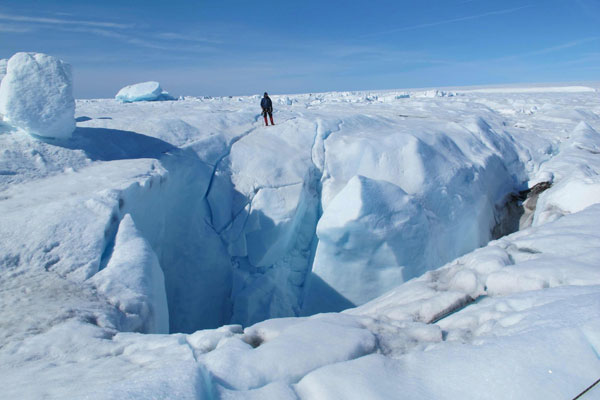Warming temperatures change the face of Greenland
Dr. Marco Tedesco, associate professor of Earth and Atmospheric Science at New York City College, and a colleague have studied the impact of climate change on the face of Greenland - where it is Dubbed the 'refrigerator of the world'.
>>>Greenland tape suddenly melted massively
By using a regional climate model and the output of three global climate models, they can predict greenhouse gas scenarios that change the face of Greenland in the next century and it will impact How to sea level rise.
The model has a large and accurate scale for a high resolution image of the future of Greenland."We put Greenland under a microscope to see what explains the melting and for ice mass changes in different regions," Professor Tedesco said.

He and his colleague Xavier Fettweis, University of Liege, Belgium, reported the results of an online study on Environmental Research Letters on November 8.
Two experts compared two possible CO 2 future scenarios: the concentration of carbon dioxide in the air expected at the end of the century was 850ppm compared to a higher level of 1370 ppm. The 850ppm level is an approximation to the current growth rate.
The Greenland ice sheet will lose more ice and snow melts more than it will accumulate in both scenarios. The basin on the southwestern and northern coasts of Greenland will suffer the most damage. The temperature will only increase by 0.6 to 2.16 degrees C (1.8-3.9 ° F) to cause imbalance, the ice will melt more than form.
This new model shows how a melt will change Greenland's topography, potentially affecting nearby ocean circulation and salinity, and boosting further melting.
Marco Tedesco said thawing will make some areas of Greenland lower altitude by about 400m from the present. This can increase the rate of melting because the temperature will be warmer at lower altitudes."Imagine an ice cream that is melting faster at an angle. This will change the shape of ice mass throughout Greenland '.
This work is supported by the National Science Foundation.
- Half of the cause of Greenland warming is natural
- Greenland Island will be completely transformed by 2100
- The iceberg was torn from Greenland
- Climate change makes the surface temperature of Greenland sea surface unusually low
- Greenland ice melted six times faster, raising global sea levels
- Global warming delays the next ice age
- The largest ice island emerged because of climate change
- Greenland ice melted like never before
- Why is Greenland covered by ice?
- See the beautiful Greenland, but it can soon be lost forever
- Greenland: Quite hunting quotas for polar white bears
- Greenland Glacier shattered, a clear sign of climate change
 Is the magnetic North Pole shift dangerous to humanity?
Is the magnetic North Pole shift dangerous to humanity? Washington legalizes the recycling of human bodies into fertilizer
Washington legalizes the recycling of human bodies into fertilizer Lightning stone - the mysterious guest
Lightning stone - the mysterious guest Stunned by the mysterious sunset, strange appearance
Stunned by the mysterious sunset, strange appearance